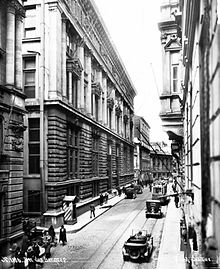Galata
The Greeks believe that the name comes either from Galatai (meaning "Gauls"), as the Celtic tribe of Gauls (Galatians) were thought to have camped here during the Hellenistic period before settling into Galatia in central Anatolia;[citation needed] or from galatas (meaning "milkman"), as the area was used by shepherds for grazing in the Early Medieval (Byzantine) period.
In historic documents, Galata is often called Pera, which comes from the old Greek name for the place, Peran en Sykais, literally "the Fig Field on the Other Side."
According to the Notitia, it featured public baths and a forum built by Emperor Honorius (r. 395–423), a theatre, a porticoed street and 435 mansions.
[2] Sykai received full city rights under Justinian I (r. 527–565), who renamed it Iustinianopolis, but declined and was probably abandoned in the 7th century.
Only the large tower, Megalos Pyrgos (the kastellion tou Galatou) which controlled the northern end of the sea chain that blocked the entrance to the Golden Horn remained.
[2] In 1233, during the subsequent Latin Empire (1204–1261), a small Catholic chapel dedicated to St. Paul was built in place of a 6th-century Byzantine church in Galata.
[6] In 1407, Pope Gregory XII, in order to ensure the maintenance of the church, conceded indulgences to the visitors of the Monastery of San Paolo in Galata.
In 1261, the quarter was retaken by the Byzantines, but Emperor Michael VIII Palaiologos (r. 1259–1282) granted it to the Genoese in 1267 in accordance with the Treaty of Nymphaeum.
With its design modeled after the 13th century wing of the Palazzo San Giorgio in Genoa,[10] the Genoese Palace was built by the Podestà of Galata, Montano De Marini.
When Constantinople fell to Mehmed the Conqueror in 1453, the neighborhood was mostly inhabited by Genoese and Venetian Catholics, though there were also some Greek, Armenian and Jewish residents.
This account is fairly consistent in records from Michael Ducas and Giovanni Lomellino; but according to Laonikos Chalkokondyles, the Genoese mayor made the decision to surrender before the fleet arrived in Galata and relinquished the keys to the Ottoman commander Zagan Pasha, not the Sultan.
One eyewitness, Leonard of Chios, describes the flight of Christians from the city:[19]"Those of them who did not manage to board their ships before the Turkish vessels reached their side of the harbor were captured; mothers were taken and their children left, or the reverse, as the case might be; and many were overcome by the sea and drowned in it.
[21] Galata and Pera in the late 19th and early 20th centuries were a part of the Municipality of the Sixth Circle (French: Municipalité du VIme Cercle), established under the laws of 11 Jumada al-Thani (Djem.









